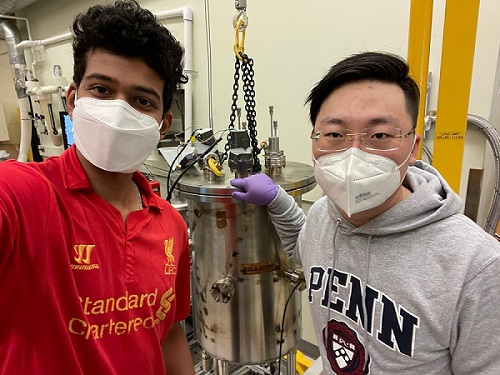Researchers at Penn State have shown a previously undescribed liquid phase in thin films of a glass-forming molecule. The work shows how thin films of glass can be fabricated to be denser and more stable, and it provides a framework for new applications and devices through improved design.
Glass is typically created through solidification of a liquid when it is cooled to a temperature where its motion arrests. The structure of a glass closely resembles the liquid phase, but its properties are similar to solids, akin to a crystal.
Glasses that are made into ultrathin, nanometer-scale films are widely used in OLED displays and optical fibers. However, when these types of glasses are made into thin films, even at cold temperatures, they behave more like a liquid, and the resulting material can be prone to droplet formation or crystallization, which limits the size of the smallest features that are possible.
To make better glasses, researchers have turned to vapor deposition instead of cooling a liquid to produce a glass; with vapor deposition, a material is changed from a gas into a solid directly. While this method has enabled researchers to create denser types of bulk glasses, it was initially believed that thin-film glasses made using this method would still have the same liquid-like properties that would lead to degradation and instability.

Shivajee Govind (left), a Ph.D. student in the lab of Zahra Fakhraai, and Yi Jin, study lead author and recent Ph.D. graduate, standing by the ultrahigh vacuum chamber that the researchers use to deposit glass thin films. Courtesy of Zahra Fakhraai, Pennsylvania State University.
However, Yi Jin, in the lab of Zahra Fakhraai, experimented to finds found that this isn’t necessarily true.
“Yi kept discovering different properties, none of the data made sense, and so we dug deeper until we had enough data to put a picture together,” Fakhraai said.
Among other experiments conducted over several years, Jin changed the glass substrate, properties, and deposition rates to ensure that all of their equipment was thoroughly cleaned to rule out contamination or experimental errors. The team found that when it used vapor deposition, it could access a different type of liquid, with a phase transition to the typical bulk liquid upon heating.
“The two liquids have distinct structures, akin to graphene and diamond, which are both solids made of carbon, but exist in very different solid forms.” Fakhraai said. “There are a lot of interesting properties that came out of nowhere, and nobody had thought that in thin films you would be able to see these phases. It’s a new type of material.”
With vapor deposition, the researchers are able to create very dense thin-film glasses, corresponding to the packing of this new liquid phase, with a density much higher than was predicted to be possible without applying immense amounts of pressure. Thin films of these glasses can have density values even higher than crystal.
To confirm their results, the team also obtained detailed structural information that showed how individual molecules are packed using equipment at Brookhaven National Laboratory. What they were seeing wasn’t just a crystal, but instead an entirely new phase in the glass. The team hypothesized that the ability to access this unique phase is because of the glass’s geometry. In that case, the work would hold implications for other types of materials as well.
“We’re developing materials that are trying to go down in terms of scale,” said Jin. “From what we see in glasses, there could also be interesting phenomena that emerge from other materials, like metallic materials that are commonly used in semiconductors, for example.”
Researchers in Fakhraai’s lab are currently studying films during the deposition process and “zooming in” on the phase transition region to learn more about this newly discovered phenomenon. This work, Fakhraai said, is also crucial for gaining better understanding of glasses as a whole, where there remains a disconnection between theories that could provide a predictive platform for developing new materials in applications and new technologies.
“To package the Moderna or Pfizer vaccines, you need a glass that could go really low in temperature and not shatter, and the fact that that technology exists is a shoutout to how well we can engineer bulk glass mechanics,” she said. “Our hope is that this fundamental understanding motivates more applications and a better ability to design thin-film glasses with similarly improved properties. If the structure-property relationships are understood in thin films, we can do better by design.”
The research was published in PNAS (www.doi.org/10.1073/pnas.2100738118).